A COIN CALLED PESO
MIGUEL L. MUÑOZ, NLG
(c) copyright 1986 by
Chicago Coin Club
Each day of the year millions of coins change hands. This is
done casually, as a matter of course, without thought or even
consideration of the fact that the name of a coin has a very
interesting history. One such denomination is the PESO which has
been used and is still being used in several countries including
Mexico.
The Peso, basis of the Mexican monetary system, has been
known by many different names over the centuries. The official
name since it was created is: Ocho Reales or Real de a Ocho -
"pieces of eight." However, shortly after its appearance, it came
to be known as Peso in the same manner that today, in Mexico,
one uses toston for the 50-cent coin, peseta for the 25-cent piece,
and in the U.S., the one cent coin is called a "penny."
But, let's see first why the coin initially was called Ocho
Reales or Real de a Ocho. In the 14th century the basis of the
monetary system in Castile, Spain, was the silver Real. This coin
was created by a decree signed by king Don Pedro the Cruel
(1350-65) with the Latin expression, Numus Regalis (royal coin).
It was given a value of three maravedis. The given name was
soon shortened to Real for common use.
A century later, Don Fernando and Doña Ysabel, the
Catholic monarchs, signed at Medina del Campo, Spain, their
royal decree dated June 13, 1497, which incorporated an
Ordenanza revamping the monetary systems of all their
kingdoms. The part referring to silver coins says:
SILVER COINS
"Item, WE order and command that in each of
our mints, other silver coins be struck and be called
Reales. These shall be sixty seven Reales to the Mark,
and not less. The fineness shall be eleven dineros and
four grains, and not less; and that from these should
be struck Reales and Half Reales and Quarter Reales
and Eighth Reales which should be weighed one by
one so that they shall be equal in weight; and that
from the silver be struck one third in Reales, one third
in Half Reales and the rest in Quarter Reales and
Eighth Reales by half part ... "
We wish to refer to the above mentioned Ordenanza,
because it has numismatic and interesting information that we
wish to discuss. We can see that it is ordered that "sixty seven
Reales to the Mark" be minted. The word Mark or Marco came
from the German word Mark as a unit of weight. For centuries it
was used as a weight unit for precious metals and it is equivalent
to the half pound of Cologne, with a weight of 230.0465 grams in
the metric system.
In the same Ordenanza, the Catholic monarchs ordered "the
weight of all coins to be tallied to the Cologne Mark when it
came to gold and silver and to the weight unit from Troy (Troyes,
France) for all other things and substances." As time rolled by,
the Cologne Mark also became known as "Marco de Castilla."
Now then, as the weight in grams of a Mark is known, it can
be divided by the number of coins ordered, 67, to obtain the
weight of each coin. This gives a weight of 3.4335, that is, almost
three and a half grams for each silver Real.
We can see also that the alloy or fineness of silver coins
should be "eleven dineros and four grains." We know that pure
silver of one thousand mills is twelve dineros and that each
dinero is divided into twenty four grains.
Therefore, if one wishes to know the fineness of a silver
coin, one can divide one thousand into twelve dineros and get
83.3333 per each dinero. This result is divided into 24 grains to
get 3.4722 per each grain. Thus, one obtains a fineness of
930.555 mills of silver in each coin. This is, by the way, the
highest silver fineness in Spanish or Spanish-American coins
ever minted. It is really higher than the so called "sterling
silver" of 925.0 mills, generally considered by silversmiths to be
the best.
A different system is used for gold. Gold of one thousand
mills is equivalent to 24 karats, and each karat is divided in four
grains. This system of karats and grains for gold is still in use
today for defining the gold content in jewelry.
As can be seen in the Ordenanza, only Reales and fractional
coins are ordered. No mention is made of silver coins larger in
denomination than the one Real. The abundance of silver from
Mexico and the need for larger denominations led to the striking
of heavier coins of two, four and, eventually, eight reales. Thus
the coin "piece of eight" came into being ... of necessity. No
royal decree ordering the coin to be struck has been found.
One must also consider that at the end of the 15th century,
Europe began to receive silver from the New World. A few
decades later the remittances increased considerably, as more
mines were being discovered in Mexico and their production
increased. The triangle formed by Guanajuato, San Luis Potosí and
Zacatecas was, and still is, the silver triangle of the world.
Recent statistics gathered by experts on the subject estimate that
approximately 60 percent of all the present silver in the world
came from the Mexican mines, for the most part from the silver
triangle mentioned above. In Europe trade and business
increased. There was need for heavier coins. Europe then had the
raw material: silver from the New World.
The Ocho Reales - eight reales - never had that value
(denomination) spelled out in the legend. All coins of this
denomination ever struck show only the abbreviation "8 R."
However, as stated above, it was called, in the Spanish world,
PESO.
There are several old documents that may prove this. Among
them, a royal decree signed at Zaragoza, Spain, March 29, 1503
by Fernando and Ysabel and sent to the Governor of the island
La Española, now Santo Domingo, that tells us:
that two foundries be erected ...
that the clergymen be paid ONE HUNDRED PESOS
per annum ..."
From this we can see that, officially, the term peso was used
to designate the eight-real piece. It also proves that for nearly
five centuries the Ocho Reales has been known as PESO. It also
tells us that the denomination peso came to us from Spain and it
did not originate in Mexico, as some historians have indicated.
Contrary to the opinion of many persons who think that for
centuries many coins have shown the legend Un Peso, this did
not happen until the last century.
The first coin with the legend UN PESO was a silver piece
struck in 1817 by Chile, followed by a second from Uruguay in
1844. Colombia struck her first coin with the legend Un Peso in
1855. Bolivia and Guatemala followed, four years later, in 1859.
Many years had to go by before Argentina struck her first Peso in
1881 with Paraguay joining in 1889.
In the last decade of the 19th century, the number of coins
with the legend Un Peso increased. There is El Salvador in 1892.
A bit later, in 1895, Puerto Rico, still as a Spanish possession.
Two years later, 1897, the Dominican Republic followed suit.
The same year, the Cuban revolutionaries in the United States
struck a coin (?) with the legend "Souvenir." The following year,
1898, the same piece was struck with the legend Un Peso.
In 1874, a curiosity was struck with the denomination Un
Peso. A French adventurer, Orllie-Antoine, declared himself
king of Patagonia in Southern Chile. He ordered coins struck
with the following legend: Obv. ORLLIE-ANTOINE I(R) ROI
D'ARAUCANIE ET DE PATAGONIE. Rev. NOUVELLE
FRANCE / UN / PESO / 1874. As stated this "coin" is only a
numismatic curiosity. It was never legal tender.
Shortly after the fall of Tenochtitlan, Mexico, D.F., on
August 13, 1521, the Spanish conquistadores continued their
explorations crossing valleys, mountains and oceans. By 1525,
Garcia de Loaiza had already crossed the Pacific Ocean. On
November 21st, 1564, Miguel Lopez Legazpi, with the title of
"Adelantado," along with the friar Andrés de Urdaneta, sailed
from Barra de Navidad on the west coast of Mexico to colonize
an archipelago in the Far East. Legazpi named the archipelago
FILIPINAS in honor of Felipe II, then king of Spain. In 1571 he
founded Manila as its capital.
Trade between New Spain (Mexico) and the Philippines
began and soon was a real institution. People used to say " ...
the Manila galleon carries, eastbound to Acapulco, porcelains
and silks; westbound, friars and silver Pesos ..."
The Far East became a very important customer for Mexican
silver coins. All the oriental countries asked for more silver coins
from Mexico. From the Philippines, the Mexican pesos passed to
India, Siam, Indochina, Japan and many other countries, but
specially China. This was due, primarily, to the fact that the
Mexican peso always maintained its silver fineness. This is also
the reason why it was nicknamed: AN HONEST DOLLAR. Last
century and even at the beginning of this, the Mexican peso was
also referred to, in business transactions, as the Mex-Dollar in
the Far East.
For nearly three centuries the Philippines, as part of the
Spanish empire, used coins minted in Spanish America, primarily
from the Mexico mint. It is only natural, therefore, that the
Philippines should use the name Peso when referring to the
Ocho Reales coin. Today they still use the denomination PISO
(sic) for their present monetary unit, an obvious reminiscence of
the long-time-used Mexican peso.
For a number of years in Mexico, Spain and, very likely,
other parts of the Spanish world, the silver two-real coin was
referred to as PESETA, "small peso", but no coin had been
struck bearing the legend Peseta. On July 21, 1808, the junta
Barcelonesa in Spain authorized the striking of a coin with the
legend: EN BARCELONA / PESETA / 1809, apparently for
circulation in Barcelona. Sixty years later, in 1868, the Gobierno
Provisional in Madrid struck the first peseta with national
circulation. Since then the monetary unit of Spain has been the Una
Peseta or small peso.
During colonial days in the U.S., the silver Ocho Reales coin,
referred to as the Spanish milled dollar, was the principal coin in
circulation. This coin and its fractional parts, the half, one, two,
and four reales, were legal currency until February 21, 1857 in
the U.S., 1858 in Canada, and 1895 in Puerto Rico. The great
majority of these coins were Mexican pesos, due to our geographical
proximity to and the large production of the Mexican mints.
From a paper read in Congress, in 1821, by the sixth President
of the United States, John Quincy Adams, one can sense the
economic condition of the country in the last few decades of the
18th century (free translation from a Spanish version):
"... at the end of our war for Independence, we found
ourselves with four English words: Pound, Shilling,
Pence and Farthing. But although they were English
words, it was difficult to find two States of the Union
in which said words represented the same value. The
use of these words was as at Babel. In our new system
we eliminated them. We took the Spanish piece of
eight, that had been always the most popular coin
among us, and gave it a new name: Dollar. Introducing
the decimal monetary system we said: the tenth
part of a dollar should be called disme (sic) and the
one hundredth part a cent, and the one thousandth
one mille ... "
So, next time you happen to have a silver dollar in your
hand, think for a second that its grandfather was an Ocho Reales
or Peso, very likely from a Mexican mint.
In Mexico, the first coin with the legend Un Peso was struck
in 1866 during the Maximilian empire. The first Republican peso
is dated 1869. It is known as Peso de Balanza, "scale peso." It is
because of their appearance during the time of Maximilian that
some people have the erroneous impression that he brought the
decimal monetary system to Mexico. This is not so. Several years
before, in 1857, Don Ignacio Comonfort, President of Mexico,
had decreed the formation of the "Dirección de Pesas y
Medidas", similar to the U.S. Bureau of Standards, and in March
15th of the same year the Decimal Monetary System was
decreed. A bit later the Decimal Monetary System was
incorporated.
Due to the political situation then prevailing in Mexico and
the French invasion of 1862, it was not possible to strike
Republican pesos until 1869. The Government of the Republic
was only able to mint decimal coins of one centavo in copper at
the Mexico city and San Luis Potosí mints and silver coins of five
and ten centavos at the San Luis Potosí mint.
We wish to call your attention to the use of the legend UN
PESO in Mexico. In this chapter metal coins have been discussed
exclusively. One must, however, make an exception and refer,
this time to paper money to point out that the legend UN PESO
appeared for the first time in Mexico on the paper money of the
First Empire of Don Agustín de Iturbide.
The decree dated December 20, 1822 authorized the issue of
four million pesos in the following manner:
| Two million |
$ 1.00 notes |
$2,000,000.00 |
| Half million |
2.00 notes |
1,000,000.00 |
| One hundred thousand |
10.00 notes |
1,000,000.00 |
| |
|
------------ |
| |
|
$4,000,000.00 |
These notes are approximately 15 x 10 cm. They are printed
in black ink and have a rudimentary look. In the text of the notes
and in the left upper corner they show the legend: UN PESO,
DOS PESOS or DIEZ PESOS.
We must add that several South American countries have
never minted coins with the denomination Un Peso. Among
them we have Perú that preferred the denomination Un Sol;
Ecuador, Un Sucre; and Venezuela, Un Bolivar. Brazil at one
time had the Reis and nowadays Un Cruzeiro.
In Central America, Nicaragua had Un Cordoba; Panama,
Un Balboa; and Costa Rica, Un Colón. The first two countries
preferred conquistadores, the third, a discoverer. It should be
noted that Costa Rica did have gold coins with the peso
denomination from 1864 to 1872.
Among the various names that the Mexican peso has been
given in Mexico, we may cite the following: peso macuquino
(cob), silver peso, circular peso, milled peso, colonial peso, old
silver peso, both worlds peso, world and seas peso, columnario
(pillar) peso, bust or face peso, resplandor (liberty cap) peso,
national peso, balanza (scale) peso, caballito (little horse) peso, etc.
But, beyond doubt, the names most widely used were: peso
fuerte (strong) and peso duro (hard) or simply DURO.
Besides the above list, admittedly incomplete, the Mexican
peso during its jaunts throughout the world received many other
names. In Italy it was known as Colonnato; in Germany, Saeulen
Piaster; in Holland, Reaal von Achten; in the English-speaking
countries, Spanish Milled Dollar, Pillar Dollar and Piece of
Eight. This last denomination was made popular by Robert Louis
Stevenson in his novel Treasure Island. In the Southeast United
States the real was referred to as a "bit;" the peseta (2 R) "two
bits;" the tostón (4 R) "four bits" and the ocho reales or Mexican
peso as "eight bits."
Although the above names are interesting, we believe that
the nickname that tops them all is the name given to our
Columnarion in Egypt. In that country it was referred to as Abu-Mafta
"two cannons". It seems that the Egyptians mistook the two
pillars of Hercules represented in the coin for two cannons.
The main reason for the denomination Peso is, no doubt, due
to its physical weight. In the trade of merchandise in general, the
factors of quality and weight are of utmost importance. It is
natural, therefore, that when man began using metals as a means
of exchange, the alloys or fineness as well as the weight of the
metals were both important. The fineness and the weight of the
metals could vary. So it was necessary to verify the fineness by
means of an assay. The weight of the coins was easy to verify
using a scale. The old Flemish masters have endowed us with their
paintings of merchants weighing coins.
Since Biblical times, the weight and value of coins have been
related. In old Babylon there was a coin called "talentum"
which, originally, had been a weight used in a scale. Nowadays
we use the word "talent" to qualify a person that has worth, like
the coin in Babylon. In the same manner the coin "shekel" used
by the Hebrews and adopted later by the Phoenicians and other
Semitic peoples, was originally a weight unit.
Since the beginning of coinage, as we can see, the value and
weight of coins have been intimately related. In ancient Greece,
as well as in the time of the Romans, the weight of a coin was
important and received constant attention. As a matter of fact, the
Roman monetary system was based on the physical weight of
the coin.
In approximately 400 B.C., the Romans began circulating a
bronze coin named As, which originally weighed one Libra, that
is, one Roman pound. The As was divided into twelve parts.
Each of these parts was called Uncia, from which we get the
word ounce used today as a weight unit. We also get the word
inch from the same word uncia. We must bear in mind that
precision in weight at that time might not have been as exact as it
is today.
Due to its physical weight, the coin called As was also
referred to as Libra. Very likely the two names were used
simultaneously. As centuries went by, the denomination As fell
into disuse; but not so the denomination libra. However, we
must point out that the physical weight of the coins was being
diminished drastically. To better illustrate this idea, one can
refer to the coin used nowadays in Italy called lira - from the
Roman libra. Instead of one pound, however, it weighs only a
few grams.
As is well known, the Roman empire covered a good part of
Europe as well as around the Mediterranean - the Romans used
to call it Mare Nostrum - "our sea". Therefore, the denomination
libra continued being used in many countries bordering the
Mediterranean basin, first as circulating coin and later as money
of account. Thus the word libra passed from Rome to Lombardy
in Northern Italy, and thence to France with the denomination
livre. At one point in history, France struck a coin with the Latin
legend: ... REX FRANCORUM ... - "king of the Franks"
(French). People began calling this coin franc and gradually the
denomination libra was replaced by franc which still is the
monetary unit of France.
Great Britain - Albion for the Greeks and Britannia for the
Romans - adopted the monetary system of the Roman invaders.
After the Romans were expelled, the Anglo-Saxons continued
using the Roman denomination libra. Britain still uses it denoted
by the capital letter L crossed by a hyphen (-), £. However, they
pronounce it "pound" from the Latin word pondus, "weight" -
that is, peso.
The denomination libra has also been used in America. Perú
struck gold coins with the denomination libra from 1898 to 1969.
In the French possessions of the Antilles, - Martinique,
Guadaloupe, etc. -, the denomination pound and/or libra/livre
was applied to the eight real coins, usually holed and/or
countermarked, minted in Spanish America, the majority from Mexican
mints. However, no coin was ever struck in the Antilles bearing
the denomination libra or livre.
We can corroborate the importance of the physical weight in
Spanish and Spanish-American coins by going back to the royal
decree of June 13, 1497, mentioned before. In the part referring
to the weight of the coin, we can read:
"THAT NO GOLD OR SILVER COIN BE WORTH IF
IT DOES NOT HAVE THE PROPER WEIGHT"
"Item, WE order and command that all
said coins in gold or silver that WE now
order to be minted, be received if they
are in weight and if they are not in
weight, they shall not be worth nor be
received in exchange or in payment or
in any other manner."
Further, in the same decree, we can read:
"Item, WE order and command that
the scale master shall receive, by the
balance needle and deliver by the
balance needle at the mint, the coins in
gold, silver or billon brought by the
merchants and the foremen and workers."
"Item, WE order and command that the
scale master and the guardians demand
that the weights, ponderals (weight
units) and the dinerals (coin weights) be
weighed before an official scribe ONCE
EVERY MONTH so neither of the two
parts receive any harm."
From the above we can see the importance that always has
been given to the physical weight of the coins, from antiquity to
our days. As we are all aware, from the end of the last century,
and more so in our present century, the use of various alloys of
copper, nickel, zinc, aluminum, as well as stainless steel, brass
and others are used more and more in the minting of coins.
Nowadays, any coin of fine metal put in circulation will have a
very short life. It can be said that such coins would immediately
be hoarded.
The coins in circulation throughout the world today have a
fiduciary rather than intrinsic value, in a similar manner to
paper money. The same piece of paper may be worth one, ten, a
hundred or a thousand, that is, the value is printed on the piece
at will. The metal content or weight of a coin is secondary.
Today the mints of the world look on metals from a different
viewpoint: availability, cost, life span, ease of manufacture, etc.
To close, I have always considered it logical that the word
"peso" was used as the denomination for the eight-real coin.
Let us look at its manufacturing process. When the flans or metal
discs were cut from the silver strip used, these flans were
weighed with a precision balance. If the flans were short in
weight they were sent back to the foundry to be melted again. If
they were overweight, small pieces were cut or filed out until
the flans had the required weight, "peso" in Spanish. This is to
say, the flans had been transformed into one weight or UN
PESO.
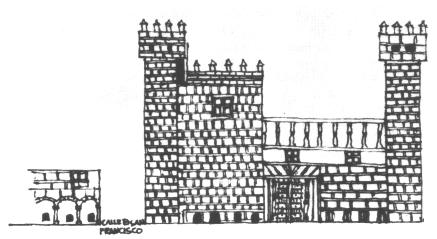
The first Mexican mint, known as the Casa de Cortés,
operated from 1535 through 1569.
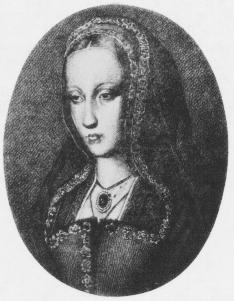
Queen Doña Juana de Castilla (1479-1555)
signed the decree authorizing the mint.
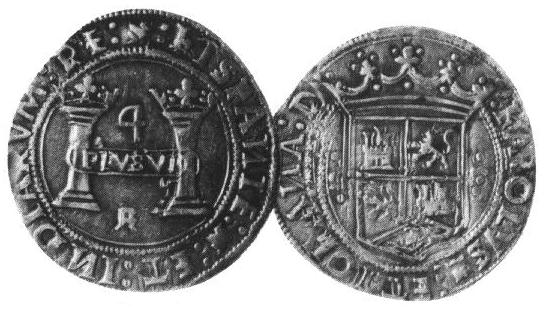
Dating from c. 1536, the first coins minted
in America were of Karolus and Johanna.
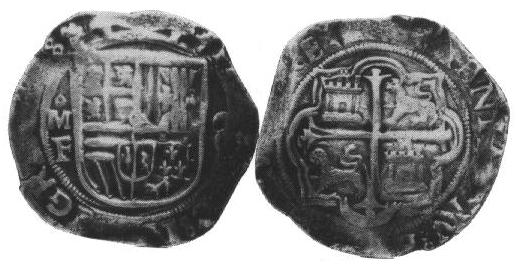
The first 8-real piece minted in America was that of
Felipe II (1556-1598).
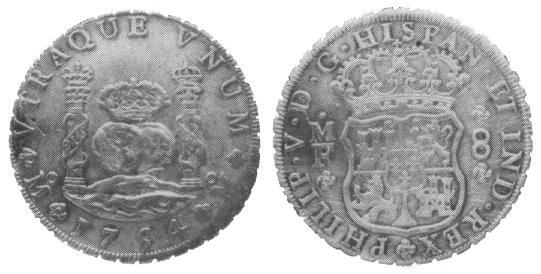
Minted from 1732-71, the coulumnario,
or pillar dollar, is regarded as the first
"universal" coin.
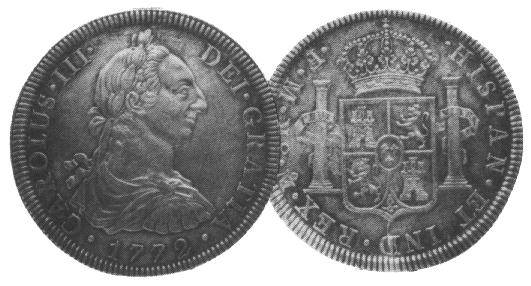
Bust-type coins, minted from 1772-1821,
carry the effigies of Carlos III,
Carlos IV, and Fernando VII.
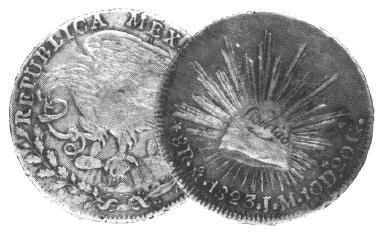
Coins depicting the liberty cap
were minted from 1823-1909.
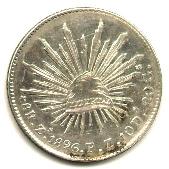
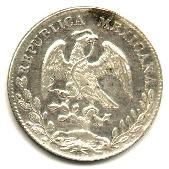
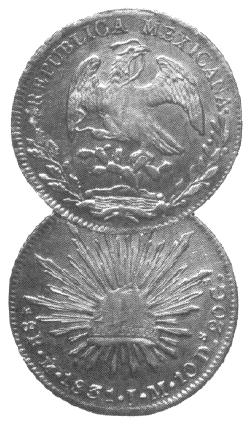
Facing eagle and liberty cap designs
were struck from 1824-1909.
return to
Perspectives in Numismatics









